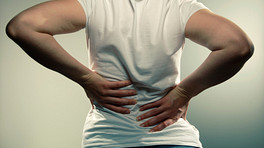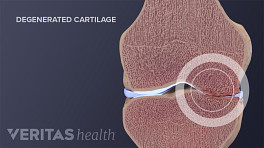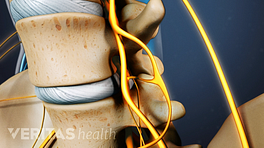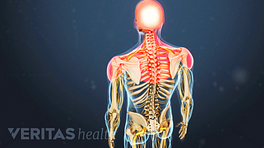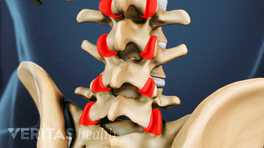Back pain, stiffness, and other spinal osteoarthritis symptoms tend to progress gradually. Knowing what symptoms to look for treating them early can slow down the progression of osteoarthritis.
This page includes a complete list and description of the common signs and symptoms of spinal osteoarthritis.
In This Article:
Back or Neck Pain
Arthritis-related back and/or neck pain depends on many variables, including how much joint degeneration has occurred and where it has developed on the spine:
- Arthritis in the lumbar spine (lower back) may cause pain in the lower back as well as the buttocks, groin, and/or back of the thigh. Radiating pain can also occur in the leg (calf or sides) and foot.
- Arthritis in the cervical spine (neck) may cause pain in the neck, shoulders, upper back, and/or middle back. Radiating pain can also occur in the arm, hand, and fingers. Frequent headaches may also occur.
The pain is often experienced as dull and aching, though there may be bouts of intense pain. Pain may be worse with certain activities, such as twisting, deep arching, heavy lifting, or high-intensity activities, such as jogging. Lying down often relieves back and neck pain.
Other Signs and Symptoms
While pain is often the most troublesome symptom of spinal osteoarthritis, other signs and symptoms may occur, including:
Back or neck stiffness
Bone friction and swelling in the facet joints may make the spine stiff and less flexible, particularly after sleeping or sitting for a long time. This stiffness may make it difficult to maintain good posture.
See How Arthritis Causes Back Pain
Worsened pain after inactivity
While lying down can relieve pain and pressure on the spine, prolonged rest may cause the spine to become stiff. People with facet joint osteoarthritis often find stiffness and pain are worse when they try to get out of bed in the morning or out of a chair after a long period of sitting. (A treatment plan can help patients find the right balance between activity and rest.)
Back popping or crunching
Feeling a crunching or hearing a popping sound when bending or arching the back are signs that cartilage may have worn away and is not protecting the facet joints from friction. The medical term for this symptom is "crepitus."
The sensation of crunching and popping is common in younger people and does not necessarily mean that joint damage has occurred. In fact, many people who experience crunching or popping have normal spine anatomy and may never have had pain.
Hunched or slouched appearance
Osteoarthritis of the spine and bad posture often go hand in hand:
- Bad posture causes the spine to curve more than normal, which puts more stress on facet joints and encourages the development of osteoarthritis.
- Osteoarthritis can set into motion a cascade of physical changes that cause the curves of the spine to become more pronounced.
Conversely, good posture can help reduce back pain and may prevent or slow down the development of osteoarthritis.
Swelling
When the cartilage of the facet joints wears away, the bones can rub together, resulting in inflammation and swelling. This swelling may be mild and go unnoticed.
Tenderness
The affected area may be tender to the touch.
Related Conditions that Cause Tingling, Numbness, or Weakness
Osteoarthritis can stimulate muscle spasms, the growth of bone spurs, or other degenerative changes that cause the spinal cord or its nerve roots to become compressed. When the spinal cord or a nerve root is squeezed, the entire area it travels to can be affected.
Separate diagnoses are used when nerve tissues are involved. These diagnoses and their symptoms and signs are described below.
Osteoarthritic-related conditions that affect the spinal nerve roots include:
- Lumbar spinal stenosis, which occurs when the size of the bony opening for a spinal nerve root in the lower back is reduced. Lumbar spinal stenosis causes the affected nerve root to become irritated or compressed as it exits the spine. A person may experience tingling, weakness, or numbness that radiates from the lower back into the buttocks, thighs, leg, and/or foot. When nerve roots between L4 to S3 in the lumbar spine are affected, the symptoms and signs are often referred to as sciatica.
Read more about Lumbar Spinal Stenosis on Spine-health.com
- Cervical spinal stenosis, which occurs when a nerve root in the neck is compressed or irritated. A person may experience tingling, weakness, or numbness that radiates to the arm or hand or fingers.
Watch: Cervical Spinal Stenosis Video on Spine-health.com
- Cervical spinal stenosis with myelopathy, which occurs when bone spurs grow inside the cervical spinal column—the space through which the spinal cord travels—and impinge on the spinal cord. It can affect a person’s fine motor skills such as handwriting and other activities that require a high degree of coordination. This serious condition is most common in elderly patients.
1
Wang XR, Kwok TCY, Griffith JF, Man Yu BW, Leung JCS, Wáng YXJ. Prevalence of cervical spine degenerative changes in elderly population and its weak association with aging, neck pain, and osteoporosis. Ann Transl Med. 2019;7(18):486. doi:10.21037/atm.2019.07.80
Read more about Cervical Spinal Stenosis with Myelopathy on Spine-health.com
- Lumbar spinal stenosis with myelopathy, which occurs when bone spurs inside the lumbar spinal column impinge on the spinal cord or nerves. This condition is not common but serious. It can affect a person’s ability to walk or stand for long periods of time. Physicians may refer to this condition as neurogenic claudication.
Read When to See a Surgeon for Spinal Stenosis on Spine-health.com
In most but not all cases, the symptoms of spinal osteoarthritis come and go, becoming worse and more frequent over months or years. If back pain comes on suddenly, it is more likely to be caused by a strained muscle or other trauma or condition, and not by spine osteoarthritis.
Early recognition of symptoms and appropriate treatment can dramatically slow or eliminate the progression of osteoarthritis symptoms.
Read more about Osteoarthritis Symptoms and Signs
- 1 Wang XR, Kwok TCY, Griffith JF, Man Yu BW, Leung JCS, Wáng YXJ. Prevalence of cervical spine degenerative changes in elderly population and its weak association with aging, neck pain, and osteoporosis. Ann Transl Med. 2019;7(18):486. doi:10.21037/atm.2019.07.80


